The Magnum-powered Dodge truck is the best combination of V-8 power and style to come out of the factory in decades. Since its introduction, many aftermarket manufacturers have jumped on the Ram/ Dakota/Durango performance bandwagon. That has helped the new powerwagons victimize more than a few Mustangs and Camaros. Staying competitive, however, means more than just producing horsepower. Looking at the entire engine-chassis combo and how it works will ensure that the dollars you spend will be cost-effective and will keep your truck in front of the pack.
Chassis Performance Recommendations
Making horsepower is one thing, but getting it to the ground is quite another. One thing is for sure, though: Attention to the chassis setup nets you lower e.t.'s at the track and better handling on the street. That's a win-win situation. Some chassis modifications are quite simple and relatively cheap. However, the more power you make, the longer you'll have to work on the chassis to get the power to the track. The following items cover every truck from mild to wild.
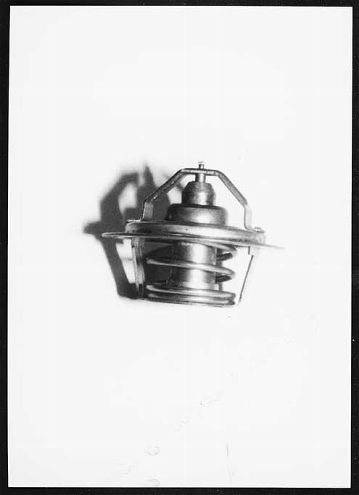
| P10038 Image Large
Cool Horsepower
Your Magnum's stock thermostat is rated at 195 degrees F. The engine controller, however, is designed to make maximum power when the engine temp is 182 degrees-a big difference. If you install a hi-perf controller but retain the 195-degree thermostat, chances are the engine will ping like crazy. Going to 94-octane gas won't cure the condition either. This is what's happening: Underloading the engine is generating higher combustion-chamber temperatures. When that happens, the coolant is air pocketing on the north side of the combustion chamber.You can easily solve these heat problems by dropping to a 180- to 185-degree thermostat. Believe it or not, lowering your engine temp 10-15 degrees will stop 90 percent of the coolant pocketing in the cylinder head. Also, you'll pick up a few horses and get slightly better gas mileage. Quite a deal for less than $10. One last thing: If you live in a place with cold winters, switch back to your stock, 195-degree thermo during that season.
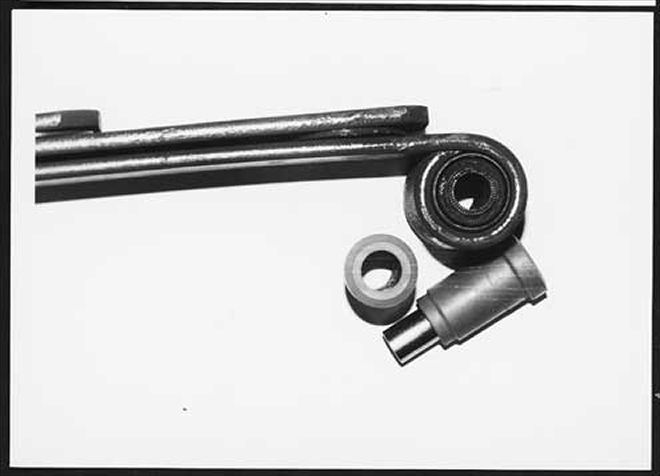
| P28725 Image Large
Eye-Maxed
The leaf springs in your truck have hard rubber mounting bushings in the spring eyes. Hard rubber is OK if you want a soft ride. Over time, the hard rubber bushings deteriorate and don't allow the leaf springs to react suitably when they have to. This is not good in any situation. By replacing the spring mounting bushings with Energy Suspension's polyurethane spring-eye bushings, you can get your springs to function properly again. This will give you quicker reaction times, better braking, and improved handling.
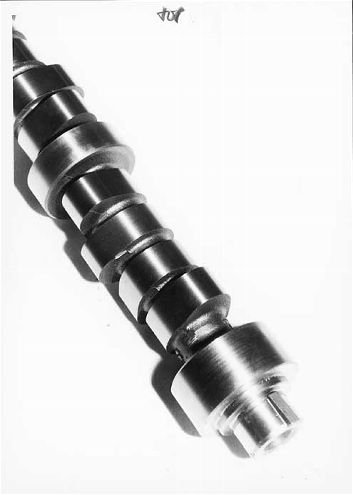
| P28712 Image Large
Firestick
Camshafting has been a standard engine power modification since the dinosaur age. Magnums, being a relatively new breed and primarily operated on the street, have only had a few aftermarket camshafts offered. Wolverine Blue Racer provides a cam regrinding service that's a great help to performance-truck buffs. Call the company and explain what you intend to do with your truck. Then pack your cam (or a core cam) and send it in. Wolverine has tons of grinds that can be tailored to a specific truck for optimum performance. Generally, street trucks should stay in the 0.450- to 0.470-inch cam lift range, and duration should not go much more than about 12-15 degrees fatter than stock, depending on the individual cam core. Many aftermarket cams are in fact reground stock jobs. Regrinding reduces the cam's base circle (the area opposite the nose) and works well if done in moderation.
Any nonstock cam needs to have these critical clearances checked: retainer-to-guide, rocker-to-retainer, and coil-bind. Failure to do so could easily result in catastrophic engine failure. Additionally, cams other than stock may also necessitate longer-than-stock pushrods, which Wolverine can supply. A reground cam within the listed specs will not require a performance computer.
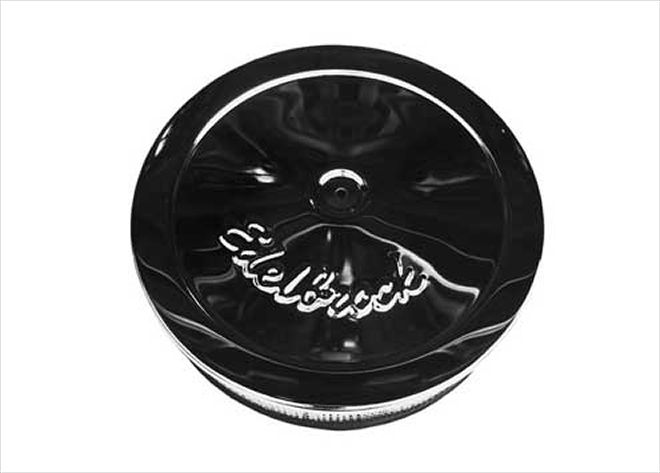
| P28701 Image Large
Fresh Breath
Magnums have been produced with two basic styles of air-filtering systems. The earlier engines came with big, round, metal units that housed a round filter element. In 1995, Chrysler redesigned the system with a divorced filter setup. Even with the cold outside air directed to the throttle body via ducting, both of the air-filtering systems leave plenty of room for performance refinement. Edelbrock offers 10- and 14-inch-diameter filters (PN 1221 with PN 8093 spacer preferred) that work wonders in performance and gas mileage. All that's required to complete the switch is to remove your old system, connect the valve cover breather line to the Edelbrock baseplate, and bend a stud mount that will hold on the top. All in all, it's about an hour's job.
How well does the new combo work? Well, if sound is any indication, the first time the motor is hammered, the possibility that you might suck in low-flying birds will seem real. Users of this system have claimed much-improved city mileage-more than a car-length at the strip.
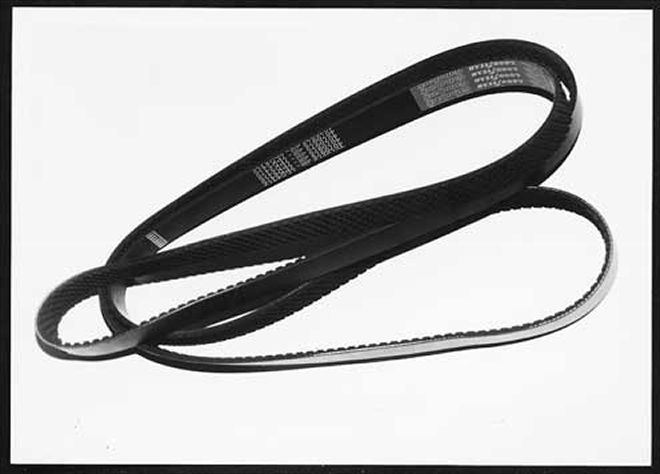
| P28717 Image Large
Getting Belted
Yup, we like our Cowboy Chryslers, especially when they come with all the power toys and air conditioning, which most Dakotas and Rams do. Well, folks, you can have the best of both worlds. Slip on down to your local parts depot and order a serpentine belt for any Magnum engine not equipped with air conditioning. When you get to the track, wrench off your engine's longer A/C belt and slide on the non-A/C belt. Your engine needs about 5 hp to turn the A/C pump due to drag, even when the A/C isn't engaged. Once you eliminate the A/C pump's drag, you'll pick up the lost power, squirting your ride a little quicker down the track. Before you return home, pop the A/C belt back on and enjoy the cool air. Here's another benefit: If you ever break down because of belt failure, you'll have another belt handy.
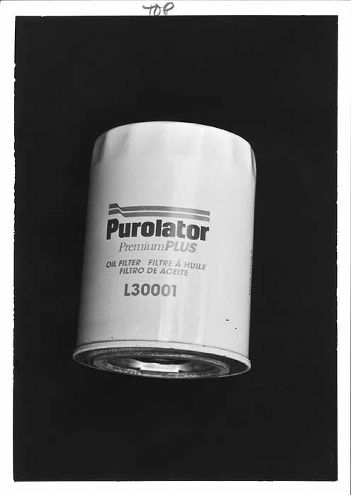
| P28706 Image Large
Keep It Clean
All 1992-and-up engines include OEM half-quart oil filters. Your engine can gain a little more capacity and greater filtration by installing a full-quart filter, such as this Purolator L30001. Hey, it's cheap and simple. Unfortunately, folks, this mod only fits two-wheel-drive trucks. Owners of 4x4s should consult the aftermarket for 1- or 2-quart remote filter setups if more filtering or greater oil capacity is desired.
Mr. Tips Says: "Check Your Rear Before You Stomp Your Foot"
Yes, you can crank more power into your engine and go faster, and you can tweak your chassis and go faster too. However, if you're talking total package, keep in mind the maxim, "A chain is only as strong as its weakest link."
See, back in the musclecar days, Mopars were known for their invincible rearends. Just about anything coming down the assembly line with a four-barrel carb also came with a superstrong 8-3/4-inch ring gear assembly. Heck, there was even a lot of 318 two-barrel cars that came with those 8-3/4 rears. If you opted for a killer motor like a six-barrel carb job or a Hemi, you got an indestructible 9-3/4-inch ringed Dana most of the time.
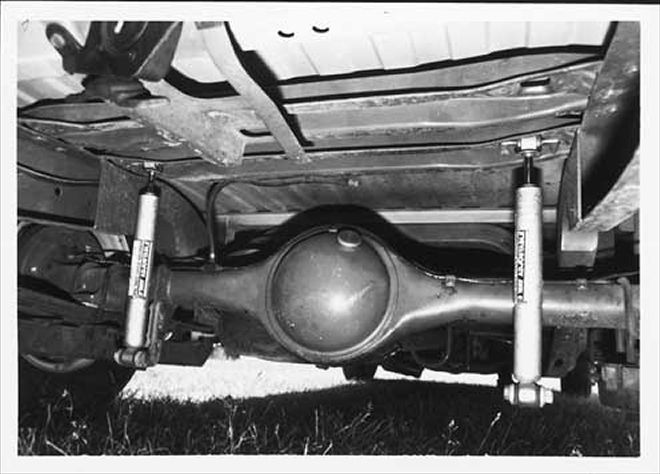
| P28722 Image Large
Well, folks, those rears aren't coming off the production line anymore. Today's standard ring gears are 8-1/4. Step up your performance, add horsepower or wide tires, and you're going to push the limits of the 81/4 rearend over the edge.
Many performance pros have used a tried-and-tuned method on their machines. They've adapted an 8-3/4 rear and just plain forgot about breakage problems. To top that off, the B-body 8-3/4 rearend gives you about 1/4 inch more tire clearance at the wheel lip moldings. Ah, things are looking better all the time. Basically what you do is get a B-body rearend, knock off the spring pads, weld on new, relocated springs pads and truck shock mounts, and tidy up the miscellaneous stuff. It's not a hard deal to pull off, even if you don't have a welder and have to pay someone to weld it. If you really want to do it right, you might want to locate 11-inch brake drums for better braking.
Just one more thing, folks: the wheels. The 8-3/4 needs five-bolt wheels, and yours are six-bolt. Check out the swap meets for 7-inch factory steel rims, or get some OE ones stretched by Stockton Wheel. Don't forget to check your offsets.
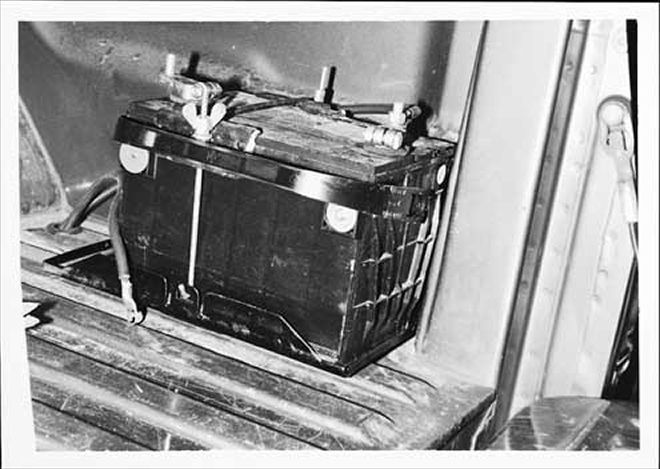
| P28724 Image Large
Performance Relocation Center
It's no secret that trucks are nose-heavy. They respond better to lightening up front. One easy way to do this is to move the battery to the right rear of the bed. This'll shift about 40 pounds behind the rear axle and will dramatically help the truck transfer weight to the rear tires. All you need is a starter relay from any 1960s or 1970s Mopar, some battery cable, a battery box, and a Saturday afternoon. Freeing the engine compartment of the battery leaves space for a second air duct to the air breather, which is what the racer shown here has.
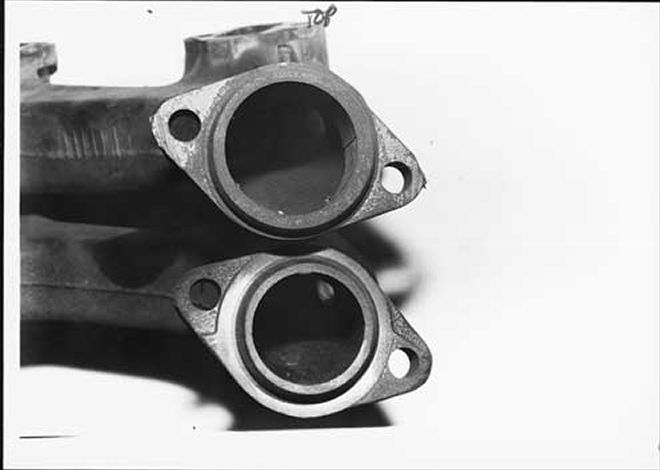
| P28708 Image Large
Pipe Dreams
All 1992 and initial-production 1993 Magnum engines had larger-diameter, better-breathing exhaust manifolds (2-1/8-inch inside diameter) than the later models (1-7/8-inch inside diameter). This accounts for the higher horsepower ratings of the earlier engines. Finding a set of the earlier manifolds would up your horsepower about 10 ponies-and look 100 percent stock. Additionally, earlier manifolds will need to be accompanied by the 1992 Y-pipe. Factory iron manifolds won't rust out and are much quieter than tube headers. Converting to them may also be slightly cheaper than going with a total header setup. The casting numbers of the 1992 large-diameter manifolds are 53006618 on the passenger side and 53006617 on the driver side.
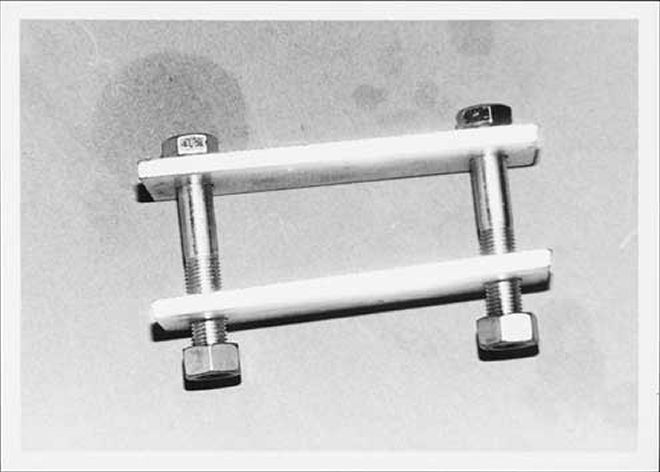
| P28723 Image Large
Put A Clamp On It
Torque-brake the Magnum-powered truck then let it go, and you'll learn to spell wheelhop. Worse, try to launch your stick-shift truck above 2,000 rpm, and your tires will bounce like a couple of basketballs in the wheelwells. That's wheelhop, and it's costing you a holeshot.
Try this simple fix: Get two pairs of Mr. Gasket spring clamps and bolt them on forward of the axle, two on each side. Now when the pinion rotates upward, the front of the springs won't arc as much, and wheelhop decreases. Cool beans. Double-check the clamps to ensure that there's no tire interference, and that's that.
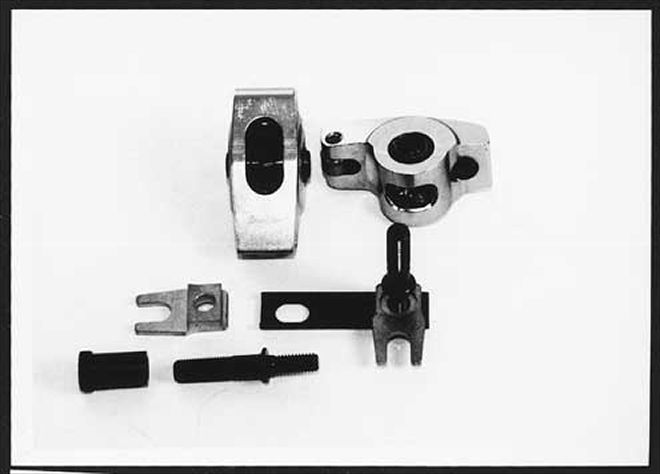
| P28707 Image Large
Rock & Roll Forever
In addition to cams, valvetrains, and a regrinding service, Wolverine offers the absolutely finest aluminum roller rockers on the planet. These aluminum, trued-ratio, roller-tipped rockers pivot on frictionless roller bearings instead of wobbly ball-and-studs. To date, they're the ultimate valvetrain for the Magnum engine. Unlike stamped aftermarket rockers that claim to be trued, the aluminum Wolverines are an undisputed 1.6:1 ratio. In addition, unlike steel rockers, the aluminum Wolverine rockers have a certain degree of impact absorption. Normal vibration traveling down the pushrods to the lifters and through the camshaft is lessened greatly, which in turn extends component life.
The other major difference between steel and aluminum rockers is their rocking style. Steel rockers use a pinch bolt that can eventually work itself loose. The Wolverine uses an Allen lock against the stud as a positive tension stop. Count on a solid 10 or 15 hp with this change. The Wolverine rockers will require holes drilled in the valve-cover baffle to clear the studs.
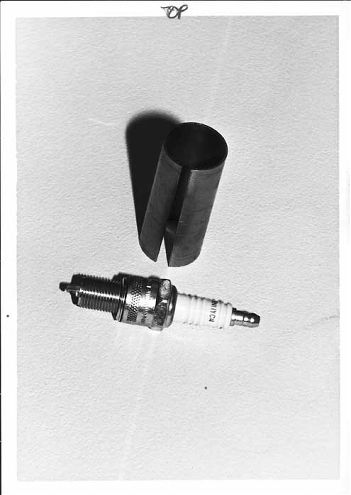
| P28710 Image Large
Spark An Interest
The Magnum engine contains C-series Champion spark plugs. The only problem is the plugs don't offer as wide a heat-range selection as the popular N-series plugs. What's a Mopar enthusiast to do? Simply remove the plug shields and spin in some Ns-that's it. A colder plug at the track would be a definite advantage. With a little experimenting, you could find the best heat-range plug on the street to improve your gas mileage. A suggested starting point would be to use N9YCs at the track and RN11YCs on the street, with a stock or near-stock engine. Remember, though, the more performance mods your engine has, the colder the plugs should be.
Spring Control
Super Stock springs were a tremendous asset to Mopar racers trying to maintain the best hookup they could get on leaf springs. Today, Landrum Spring Service can set up your truck with a pair of custom-tailored leaf springs that offer maximum traction and handling on any kind of pavement, similar to the legendary SS springs. Landrum leaf springs are made from quality chrome vanadium spring steel and contain Teflon inserts to prevent inner leaf friction. Also, they're diamond-trimmed at the leaves to maintain consistent spring rates. You'll get the best bite this side of a four-link with these custom springs.
-
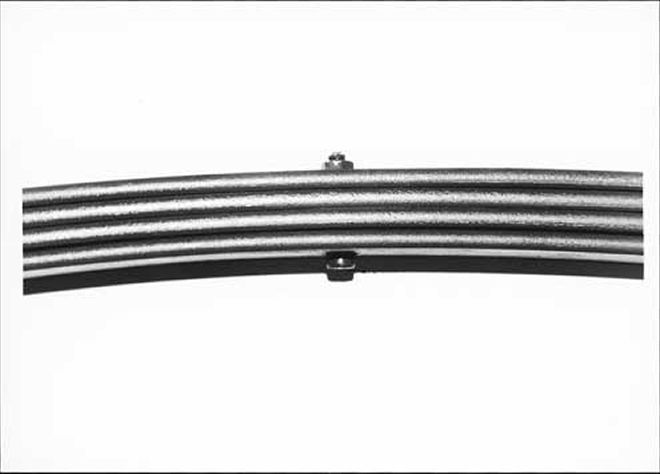
-
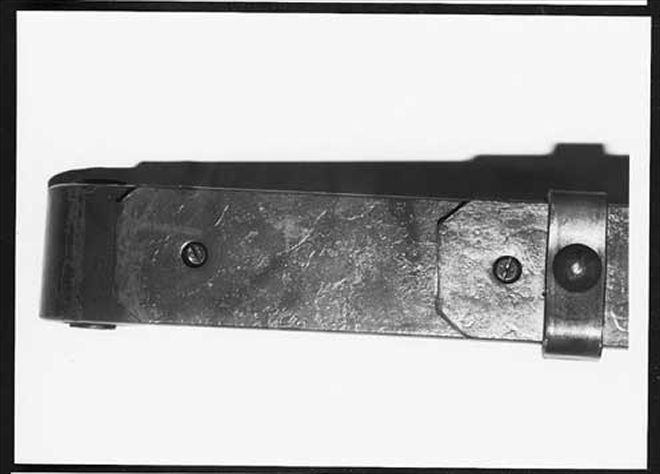
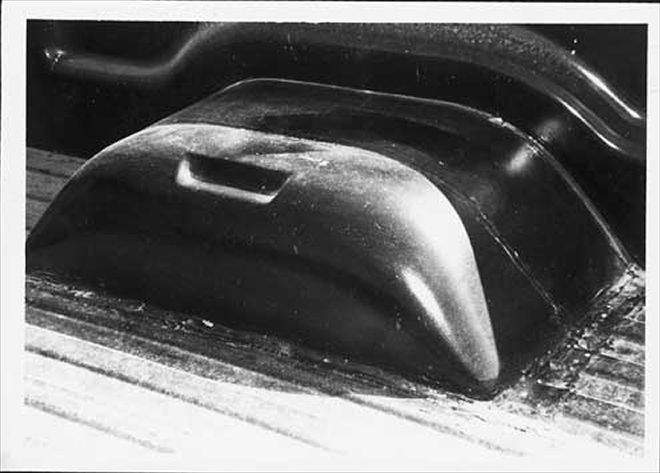
| P28726 Image Large
Tubs Of Fun
If your Ram or Dakota isn't a full-time hauler, here's a serious body alteration that will provide lots of room for monster-size Pro Street tires. Section the OEM wheeltub down the center, then cut out the bed floor to the framerail, where the tub half will be moved. Weld the sectioned tub inboard. You should have a gap of a few inches between the half of the outside, untouched tub and the moved-inboard tub. Fill the gap with a 3-inch strip of metal, paint it, and you're down the road. Now you'll have room to move the framerails inboard, and the job of stretching will be complete.
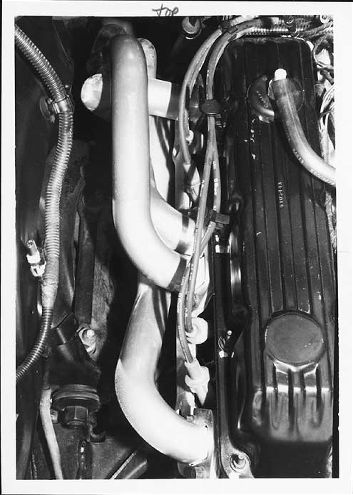
| P28711 Image Large
Tubular, Dude
If maximum power is your game plan, tube headers are for you. Until now, headers for Magnums have been the shortie variety that bolts into the stock Y-pipes, such as those available from any JBA Headers retailer. Hooker offers Magnum owners a full-length, 1-5/8-inch primary tube and collector that eliminates the restrictive Y-pipe. This type of header is specifically designed for track engines. If you're looking for a header that will make the most horsepower, this is it. The full-length Hooker isn't a bolt-in modification. It will require a custom exhaust system past the collector and minor collector-to-chassis clearancing, whereas the shorties are bolt-in.
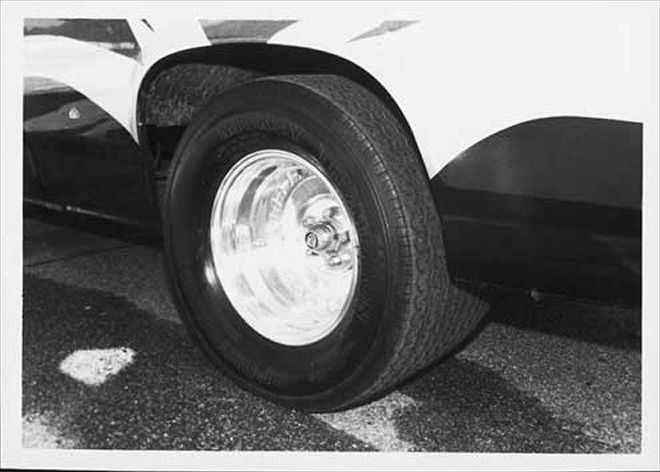
| P28727 Image Large
Well Wishes
Professional chassis builders will tell you that lowering a vehicle helps traction and handling, but the Pro Street, big, fat tire look could easily slam the tires into the fender lips on bump impact, ruining the body panel and destroying the truck's handling. And that's not good. Most body shops can stretch your wheelwells a few inches, giving your Dodge a stock appearance. This is an old racing modification that works much better than flaring out the lips.
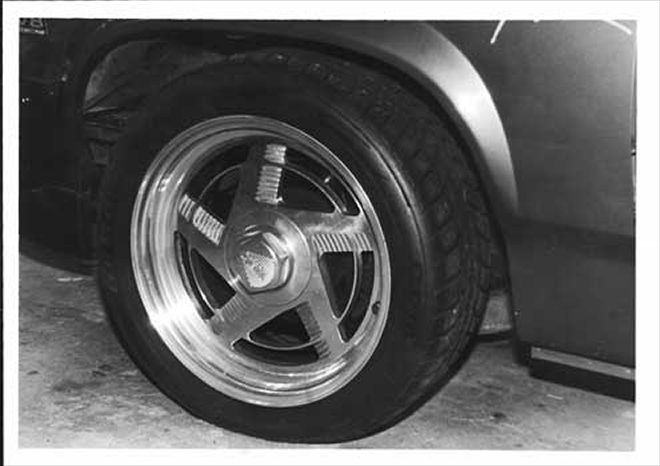
| P28721 Image Large
Wheel Of Fortune
This is the place to start. Most stock wheels are only 6 inches wide, with 7 inches optional. The big Rams can come with a littler wider wheels if you opt for one of the sport packages. In any case, wide and lightweight aluminum wheels designed to wear 16- and 17-inch tires are a major improvement over stock wheels. Wheels with diameters of 16 or 17 inches can mount tires that have stiffer sidewalls and a greater pavement-contact area, thereby aiding both twisty and straight-line traction concerns. The 17-inch Weld wheel and 45-series BFGoodrich tire shown here will give your truck fighter-plane handling in the corners and greater bite at the track. Hey, they'll improve your truck's looks and lower it too.
 | P10038 Image Large
Cool Horsepower
Your Magnum's stock thermostat is rated at 195 degrees F. The engine controller, however, is designed to make maximum power when the engine temp is 182 degrees-a big difference. If you install a hi-perf controller but retain the 195-degree thermostat, chances are the engine will ping like crazy. Going to 94-octane gas won't cure the condition either. This is what's happening: Underloading the engine is generating higher combustion-chamber temperatures. When that happens, the coolant is air pocketing on the north side of the combustion chamber.You can easily solve these heat problems by dropping to a 180- to 185-degree thermostat. Believe it or not, lowering your engine temp 10-15 degrees will stop 90 percent of the coolant pocketing in the cylinder head. Also, you'll pick up a few horses and get slightly better gas mileage. Quite a deal for less than $10. One last thing: If you live in a place with cold winters, switch back to your stock, 195-degree thermo during that season.
| P10038 Image Large
Cool Horsepower
Your Magnum's stock thermostat is rated at 195 degrees F. The engine controller, however, is designed to make maximum power when the engine temp is 182 degrees-a big difference. If you install a hi-perf controller but retain the 195-degree thermostat, chances are the engine will ping like crazy. Going to 94-octane gas won't cure the condition either. This is what's happening: Underloading the engine is generating higher combustion-chamber temperatures. When that happens, the coolant is air pocketing on the north side of the combustion chamber.You can easily solve these heat problems by dropping to a 180- to 185-degree thermostat. Believe it or not, lowering your engine temp 10-15 degrees will stop 90 percent of the coolant pocketing in the cylinder head. Also, you'll pick up a few horses and get slightly better gas mileage. Quite a deal for less than $10. One last thing: If you live in a place with cold winters, switch back to your stock, 195-degree thermo during that season.
 | P28725 Image Large
Eye-Maxed
The leaf springs in your truck have hard rubber mounting bushings in the spring eyes. Hard rubber is OK if you want a soft ride. Over time, the hard rubber bushings deteriorate and don't allow the leaf springs to react suitably when they have to. This is not good in any situation. By replacing the spring mounting bushings with Energy Suspension's polyurethane spring-eye bushings, you can get your springs to function properly again. This will give you quicker reaction times, better braking, and improved handling.
| P28725 Image Large
Eye-Maxed
The leaf springs in your truck have hard rubber mounting bushings in the spring eyes. Hard rubber is OK if you want a soft ride. Over time, the hard rubber bushings deteriorate and don't allow the leaf springs to react suitably when they have to. This is not good in any situation. By replacing the spring mounting bushings with Energy Suspension's polyurethane spring-eye bushings, you can get your springs to function properly again. This will give you quicker reaction times, better braking, and improved handling.
 | P28712 Image Large
Firestick
Camshafting has been a standard engine power modification since the dinosaur age. Magnums, being a relatively new breed and primarily operated on the street, have only had a few aftermarket camshafts offered. Wolverine Blue Racer provides a cam regrinding service that's a great help to performance-truck buffs. Call the company and explain what you intend to do with your truck. Then pack your cam (or a core cam) and send it in. Wolverine has tons of grinds that can be tailored to a specific truck for optimum performance. Generally, street trucks should stay in the 0.450- to 0.470-inch cam lift range, and duration should not go much more than about 12-15 degrees fatter than stock, depending on the individual cam core. Many aftermarket cams are in fact reground stock jobs. Regrinding reduces the cam's base circle (the area opposite the nose) and works well if done in moderation.
Any nonstock cam needs to have these critical clearances checked: retainer-to-guide, rocker-to-retainer, and coil-bind. Failure to do so could easily result in catastrophic engine failure. Additionally, cams other than stock may also necessitate longer-than-stock pushrods, which Wolverine can supply. A reground cam within the listed specs will not require a performance computer.
| P28712 Image Large
Firestick
Camshafting has been a standard engine power modification since the dinosaur age. Magnums, being a relatively new breed and primarily operated on the street, have only had a few aftermarket camshafts offered. Wolverine Blue Racer provides a cam regrinding service that's a great help to performance-truck buffs. Call the company and explain what you intend to do with your truck. Then pack your cam (or a core cam) and send it in. Wolverine has tons of grinds that can be tailored to a specific truck for optimum performance. Generally, street trucks should stay in the 0.450- to 0.470-inch cam lift range, and duration should not go much more than about 12-15 degrees fatter than stock, depending on the individual cam core. Many aftermarket cams are in fact reground stock jobs. Regrinding reduces the cam's base circle (the area opposite the nose) and works well if done in moderation.
Any nonstock cam needs to have these critical clearances checked: retainer-to-guide, rocker-to-retainer, and coil-bind. Failure to do so could easily result in catastrophic engine failure. Additionally, cams other than stock may also necessitate longer-than-stock pushrods, which Wolverine can supply. A reground cam within the listed specs will not require a performance computer.
 | P28701 Image Large
Fresh Breath
Magnums have been produced with two basic styles of air-filtering systems. The earlier engines came with big, round, metal units that housed a round filter element. In 1995, Chrysler redesigned the system with a divorced filter setup. Even with the cold outside air directed to the throttle body via ducting, both of the air-filtering systems leave plenty of room for performance refinement. Edelbrock offers 10- and 14-inch-diameter filters (PN 1221 with PN 8093 spacer preferred) that work wonders in performance and gas mileage. All that's required to complete the switch is to remove your old system, connect the valve cover breather line to the Edelbrock baseplate, and bend a stud mount that will hold on the top. All in all, it's about an hour's job.
How well does the new combo work? Well, if sound is any indication, the first time the motor is hammered, the possibility that you might suck in low-flying birds will seem real. Users of this system have claimed much-improved city mileage-more than a car-length at the strip.
| P28701 Image Large
Fresh Breath
Magnums have been produced with two basic styles of air-filtering systems. The earlier engines came with big, round, metal units that housed a round filter element. In 1995, Chrysler redesigned the system with a divorced filter setup. Even with the cold outside air directed to the throttle body via ducting, both of the air-filtering systems leave plenty of room for performance refinement. Edelbrock offers 10- and 14-inch-diameter filters (PN 1221 with PN 8093 spacer preferred) that work wonders in performance and gas mileage. All that's required to complete the switch is to remove your old system, connect the valve cover breather line to the Edelbrock baseplate, and bend a stud mount that will hold on the top. All in all, it's about an hour's job.
How well does the new combo work? Well, if sound is any indication, the first time the motor is hammered, the possibility that you might suck in low-flying birds will seem real. Users of this system have claimed much-improved city mileage-more than a car-length at the strip.
 | P28717 Image Large
Getting Belted
Yup, we like our Cowboy Chryslers, especially when they come with all the power toys and air conditioning, which most Dakotas and Rams do. Well, folks, you can have the best of both worlds. Slip on down to your local parts depot and order a serpentine belt for any Magnum engine not equipped with air conditioning. When you get to the track, wrench off your engine's longer A/C belt and slide on the non-A/C belt. Your engine needs about 5 hp to turn the A/C pump due to drag, even when the A/C isn't engaged. Once you eliminate the A/C pump's drag, you'll pick up the lost power, squirting your ride a little quicker down the track. Before you return home, pop the A/C belt back on and enjoy the cool air. Here's another benefit: If you ever break down because of belt failure, you'll have another belt handy.
| P28717 Image Large
Getting Belted
Yup, we like our Cowboy Chryslers, especially when they come with all the power toys and air conditioning, which most Dakotas and Rams do. Well, folks, you can have the best of both worlds. Slip on down to your local parts depot and order a serpentine belt for any Magnum engine not equipped with air conditioning. When you get to the track, wrench off your engine's longer A/C belt and slide on the non-A/C belt. Your engine needs about 5 hp to turn the A/C pump due to drag, even when the A/C isn't engaged. Once you eliminate the A/C pump's drag, you'll pick up the lost power, squirting your ride a little quicker down the track. Before you return home, pop the A/C belt back on and enjoy the cool air. Here's another benefit: If you ever break down because of belt failure, you'll have another belt handy.
 | P28706 Image Large
Keep It Clean
All 1992-and-up engines include OEM half-quart oil filters. Your engine can gain a little more capacity and greater filtration by installing a full-quart filter, such as this Purolator L30001. Hey, it's cheap and simple. Unfortunately, folks, this mod only fits two-wheel-drive trucks. Owners of 4x4s should consult the aftermarket for 1- or 2-quart remote filter setups if more filtering or greater oil capacity is desired.
Mr. Tips Says: "Check Your Rear Before You Stomp Your Foot"
Yes, you can crank more power into your engine and go faster, and you can tweak your chassis and go faster too. However, if you're talking total package, keep in mind the maxim, "A chain is only as strong as its weakest link."
See, back in the musclecar days, Mopars were known for their invincible rearends. Just about anything coming down the assembly line with a four-barrel carb also came with a superstrong 8-3/4-inch ring gear assembly. Heck, there was even a lot of 318 two-barrel cars that came with those 8-3/4 rears. If you opted for a killer motor like a six-barrel carb job or a Hemi, you got an indestructible 9-3/4-inch ringed Dana most of the time.
| P28706 Image Large
Keep It Clean
All 1992-and-up engines include OEM half-quart oil filters. Your engine can gain a little more capacity and greater filtration by installing a full-quart filter, such as this Purolator L30001. Hey, it's cheap and simple. Unfortunately, folks, this mod only fits two-wheel-drive trucks. Owners of 4x4s should consult the aftermarket for 1- or 2-quart remote filter setups if more filtering or greater oil capacity is desired.
Mr. Tips Says: "Check Your Rear Before You Stomp Your Foot"
Yes, you can crank more power into your engine and go faster, and you can tweak your chassis and go faster too. However, if you're talking total package, keep in mind the maxim, "A chain is only as strong as its weakest link."
See, back in the musclecar days, Mopars were known for their invincible rearends. Just about anything coming down the assembly line with a four-barrel carb also came with a superstrong 8-3/4-inch ring gear assembly. Heck, there was even a lot of 318 two-barrel cars that came with those 8-3/4 rears. If you opted for a killer motor like a six-barrel carb job or a Hemi, you got an indestructible 9-3/4-inch ringed Dana most of the time.
 | P28722 Image Large
Well, folks, those rears aren't coming off the production line anymore. Today's standard ring gears are 8-1/4. Step up your performance, add horsepower or wide tires, and you're going to push the limits of the 81/4 rearend over the edge.
Many performance pros have used a tried-and-tuned method on their machines. They've adapted an 8-3/4 rear and just plain forgot about breakage problems. To top that off, the B-body 8-3/4 rearend gives you about 1/4 inch more tire clearance at the wheel lip moldings. Ah, things are looking better all the time. Basically what you do is get a B-body rearend, knock off the spring pads, weld on new, relocated springs pads and truck shock mounts, and tidy up the miscellaneous stuff. It's not a hard deal to pull off, even if you don't have a welder and have to pay someone to weld it. If you really want to do it right, you might want to locate 11-inch brake drums for better braking.
Just one more thing, folks: the wheels. The 8-3/4 needs five-bolt wheels, and yours are six-bolt. Check out the swap meets for 7-inch factory steel rims, or get some OE ones stretched by Stockton Wheel. Don't forget to check your offsets.
| P28722 Image Large
Well, folks, those rears aren't coming off the production line anymore. Today's standard ring gears are 8-1/4. Step up your performance, add horsepower or wide tires, and you're going to push the limits of the 81/4 rearend over the edge.
Many performance pros have used a tried-and-tuned method on their machines. They've adapted an 8-3/4 rear and just plain forgot about breakage problems. To top that off, the B-body 8-3/4 rearend gives you about 1/4 inch more tire clearance at the wheel lip moldings. Ah, things are looking better all the time. Basically what you do is get a B-body rearend, knock off the spring pads, weld on new, relocated springs pads and truck shock mounts, and tidy up the miscellaneous stuff. It's not a hard deal to pull off, even if you don't have a welder and have to pay someone to weld it. If you really want to do it right, you might want to locate 11-inch brake drums for better braking.
Just one more thing, folks: the wheels. The 8-3/4 needs five-bolt wheels, and yours are six-bolt. Check out the swap meets for 7-inch factory steel rims, or get some OE ones stretched by Stockton Wheel. Don't forget to check your offsets.
 | P28724 Image Large
Performance Relocation Center
It's no secret that trucks are nose-heavy. They respond better to lightening up front. One easy way to do this is to move the battery to the right rear of the bed. This'll shift about 40 pounds behind the rear axle and will dramatically help the truck transfer weight to the rear tires. All you need is a starter relay from any 1960s or 1970s Mopar, some battery cable, a battery box, and a Saturday afternoon. Freeing the engine compartment of the battery leaves space for a second air duct to the air breather, which is what the racer shown here has.
| P28724 Image Large
Performance Relocation Center
It's no secret that trucks are nose-heavy. They respond better to lightening up front. One easy way to do this is to move the battery to the right rear of the bed. This'll shift about 40 pounds behind the rear axle and will dramatically help the truck transfer weight to the rear tires. All you need is a starter relay from any 1960s or 1970s Mopar, some battery cable, a battery box, and a Saturday afternoon. Freeing the engine compartment of the battery leaves space for a second air duct to the air breather, which is what the racer shown here has.
 | P28708 Image Large
Pipe Dreams
All 1992 and initial-production 1993 Magnum engines had larger-diameter, better-breathing exhaust manifolds (2-1/8-inch inside diameter) than the later models (1-7/8-inch inside diameter). This accounts for the higher horsepower ratings of the earlier engines. Finding a set of the earlier manifolds would up your horsepower about 10 ponies-and look 100 percent stock. Additionally, earlier manifolds will need to be accompanied by the 1992 Y-pipe. Factory iron manifolds won't rust out and are much quieter than tube headers. Converting to them may also be slightly cheaper than going with a total header setup. The casting numbers of the 1992 large-diameter manifolds are 53006618 on the passenger side and 53006617 on the driver side.
| P28708 Image Large
Pipe Dreams
All 1992 and initial-production 1993 Magnum engines had larger-diameter, better-breathing exhaust manifolds (2-1/8-inch inside diameter) than the later models (1-7/8-inch inside diameter). This accounts for the higher horsepower ratings of the earlier engines. Finding a set of the earlier manifolds would up your horsepower about 10 ponies-and look 100 percent stock. Additionally, earlier manifolds will need to be accompanied by the 1992 Y-pipe. Factory iron manifolds won't rust out and are much quieter than tube headers. Converting to them may also be slightly cheaper than going with a total header setup. The casting numbers of the 1992 large-diameter manifolds are 53006618 on the passenger side and 53006617 on the driver side.
 | P28723 Image Large
Put A Clamp On It
Torque-brake the Magnum-powered truck then let it go, and you'll learn to spell wheelhop. Worse, try to launch your stick-shift truck above 2,000 rpm, and your tires will bounce like a couple of basketballs in the wheelwells. That's wheelhop, and it's costing you a holeshot.
Try this simple fix: Get two pairs of Mr. Gasket spring clamps and bolt them on forward of the axle, two on each side. Now when the pinion rotates upward, the front of the springs won't arc as much, and wheelhop decreases. Cool beans. Double-check the clamps to ensure that there's no tire interference, and that's that.
| P28723 Image Large
Put A Clamp On It
Torque-brake the Magnum-powered truck then let it go, and you'll learn to spell wheelhop. Worse, try to launch your stick-shift truck above 2,000 rpm, and your tires will bounce like a couple of basketballs in the wheelwells. That's wheelhop, and it's costing you a holeshot.
Try this simple fix: Get two pairs of Mr. Gasket spring clamps and bolt them on forward of the axle, two on each side. Now when the pinion rotates upward, the front of the springs won't arc as much, and wheelhop decreases. Cool beans. Double-check the clamps to ensure that there's no tire interference, and that's that.
 | P28707 Image Large
Rock & Roll Forever
In addition to cams, valvetrains, and a regrinding service, Wolverine offers the absolutely finest aluminum roller rockers on the planet. These aluminum, trued-ratio, roller-tipped rockers pivot on frictionless roller bearings instead of wobbly ball-and-studs. To date, they're the ultimate valvetrain for the Magnum engine. Unlike stamped aftermarket rockers that claim to be trued, the aluminum Wolverines are an undisputed 1.6:1 ratio. In addition, unlike steel rockers, the aluminum Wolverine rockers have a certain degree of impact absorption. Normal vibration traveling down the pushrods to the lifters and through the camshaft is lessened greatly, which in turn extends component life.
The other major difference between steel and aluminum rockers is their rocking style. Steel rockers use a pinch bolt that can eventually work itself loose. The Wolverine uses an Allen lock against the stud as a positive tension stop. Count on a solid 10 or 15 hp with this change. The Wolverine rockers will require holes drilled in the valve-cover baffle to clear the studs.
| P28707 Image Large
Rock & Roll Forever
In addition to cams, valvetrains, and a regrinding service, Wolverine offers the absolutely finest aluminum roller rockers on the planet. These aluminum, trued-ratio, roller-tipped rockers pivot on frictionless roller bearings instead of wobbly ball-and-studs. To date, they're the ultimate valvetrain for the Magnum engine. Unlike stamped aftermarket rockers that claim to be trued, the aluminum Wolverines are an undisputed 1.6:1 ratio. In addition, unlike steel rockers, the aluminum Wolverine rockers have a certain degree of impact absorption. Normal vibration traveling down the pushrods to the lifters and through the camshaft is lessened greatly, which in turn extends component life.
The other major difference between steel and aluminum rockers is their rocking style. Steel rockers use a pinch bolt that can eventually work itself loose. The Wolverine uses an Allen lock against the stud as a positive tension stop. Count on a solid 10 or 15 hp with this change. The Wolverine rockers will require holes drilled in the valve-cover baffle to clear the studs.
 | P28710 Image Large
Spark An Interest
The Magnum engine contains C-series Champion spark plugs. The only problem is the plugs don't offer as wide a heat-range selection as the popular N-series plugs. What's a Mopar enthusiast to do? Simply remove the plug shields and spin in some Ns-that's it. A colder plug at the track would be a definite advantage. With a little experimenting, you could find the best heat-range plug on the street to improve your gas mileage. A suggested starting point would be to use N9YCs at the track and RN11YCs on the street, with a stock or near-stock engine. Remember, though, the more performance mods your engine has, the colder the plugs should be.
Spring Control
Super Stock springs were a tremendous asset to Mopar racers trying to maintain the best hookup they could get on leaf springs. Today, Landrum Spring Service can set up your truck with a pair of custom-tailored leaf springs that offer maximum traction and handling on any kind of pavement, similar to the legendary SS springs. Landrum leaf springs are made from quality chrome vanadium spring steel and contain Teflon inserts to prevent inner leaf friction. Also, they're diamond-trimmed at the leaves to maintain consistent spring rates. You'll get the best bite this side of a four-link with these custom springs.
| P28710 Image Large
Spark An Interest
The Magnum engine contains C-series Champion spark plugs. The only problem is the plugs don't offer as wide a heat-range selection as the popular N-series plugs. What's a Mopar enthusiast to do? Simply remove the plug shields and spin in some Ns-that's it. A colder plug at the track would be a definite advantage. With a little experimenting, you could find the best heat-range plug on the street to improve your gas mileage. A suggested starting point would be to use N9YCs at the track and RN11YCs on the street, with a stock or near-stock engine. Remember, though, the more performance mods your engine has, the colder the plugs should be.
Spring Control
Super Stock springs were a tremendous asset to Mopar racers trying to maintain the best hookup they could get on leaf springs. Today, Landrum Spring Service can set up your truck with a pair of custom-tailored leaf springs that offer maximum traction and handling on any kind of pavement, similar to the legendary SS springs. Landrum leaf springs are made from quality chrome vanadium spring steel and contain Teflon inserts to prevent inner leaf friction. Also, they're diamond-trimmed at the leaves to maintain consistent spring rates. You'll get the best bite this side of a four-link with these custom springs.


 | P28726 Image Large
Tubs Of Fun
If your Ram or Dakota isn't a full-time hauler, here's a serious body alteration that will provide lots of room for monster-size Pro Street tires. Section the OEM wheeltub down the center, then cut out the bed floor to the framerail, where the tub half will be moved. Weld the sectioned tub inboard. You should have a gap of a few inches between the half of the outside, untouched tub and the moved-inboard tub. Fill the gap with a 3-inch strip of metal, paint it, and you're down the road. Now you'll have room to move the framerails inboard, and the job of stretching will be complete.
| P28726 Image Large
Tubs Of Fun
If your Ram or Dakota isn't a full-time hauler, here's a serious body alteration that will provide lots of room for monster-size Pro Street tires. Section the OEM wheeltub down the center, then cut out the bed floor to the framerail, where the tub half will be moved. Weld the sectioned tub inboard. You should have a gap of a few inches between the half of the outside, untouched tub and the moved-inboard tub. Fill the gap with a 3-inch strip of metal, paint it, and you're down the road. Now you'll have room to move the framerails inboard, and the job of stretching will be complete.
 | P28711 Image Large
Tubular, Dude
If maximum power is your game plan, tube headers are for you. Until now, headers for Magnums have been the shortie variety that bolts into the stock Y-pipes, such as those available from any JBA Headers retailer. Hooker offers Magnum owners a full-length, 1-5/8-inch primary tube and collector that eliminates the restrictive Y-pipe. This type of header is specifically designed for track engines. If you're looking for a header that will make the most horsepower, this is it. The full-length Hooker isn't a bolt-in modification. It will require a custom exhaust system past the collector and minor collector-to-chassis clearancing, whereas the shorties are bolt-in.
| P28711 Image Large
Tubular, Dude
If maximum power is your game plan, tube headers are for you. Until now, headers for Magnums have been the shortie variety that bolts into the stock Y-pipes, such as those available from any JBA Headers retailer. Hooker offers Magnum owners a full-length, 1-5/8-inch primary tube and collector that eliminates the restrictive Y-pipe. This type of header is specifically designed for track engines. If you're looking for a header that will make the most horsepower, this is it. The full-length Hooker isn't a bolt-in modification. It will require a custom exhaust system past the collector and minor collector-to-chassis clearancing, whereas the shorties are bolt-in.
 | P28727 Image Large
Well Wishes
Professional chassis builders will tell you that lowering a vehicle helps traction and handling, but the Pro Street, big, fat tire look could easily slam the tires into the fender lips on bump impact, ruining the body panel and destroying the truck's handling. And that's not good. Most body shops can stretch your wheelwells a few inches, giving your Dodge a stock appearance. This is an old racing modification that works much better than flaring out the lips.
| P28727 Image Large
Well Wishes
Professional chassis builders will tell you that lowering a vehicle helps traction and handling, but the Pro Street, big, fat tire look could easily slam the tires into the fender lips on bump impact, ruining the body panel and destroying the truck's handling. And that's not good. Most body shops can stretch your wheelwells a few inches, giving your Dodge a stock appearance. This is an old racing modification that works much better than flaring out the lips.
 | P28721 Image Large
Wheel Of Fortune
This is the place to start. Most stock wheels are only 6 inches wide, with 7 inches optional. The big Rams can come with a littler wider wheels if you opt for one of the sport packages. In any case, wide and lightweight aluminum wheels designed to wear 16- and 17-inch tires are a major improvement over stock wheels. Wheels with diameters of 16 or 17 inches can mount tires that have stiffer sidewalls and a greater pavement-contact area, thereby aiding both twisty and straight-line traction concerns. The 17-inch Weld wheel and 45-series BFGoodrich tire shown here will give your truck fighter-plane handling in the corners and greater bite at the track. Hey, they'll improve your truck's looks and lower it too.
| P28721 Image Large
Wheel Of Fortune
This is the place to start. Most stock wheels are only 6 inches wide, with 7 inches optional. The big Rams can come with a littler wider wheels if you opt for one of the sport packages. In any case, wide and lightweight aluminum wheels designed to wear 16- and 17-inch tires are a major improvement over stock wheels. Wheels with diameters of 16 or 17 inches can mount tires that have stiffer sidewalls and a greater pavement-contact area, thereby aiding both twisty and straight-line traction concerns. The 17-inch Weld wheel and 45-series BFGoodrich tire shown here will give your truck fighter-plane handling in the corners and greater bite at the track. Hey, they'll improve your truck's looks and lower it too.